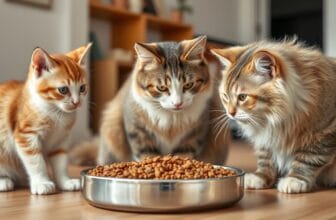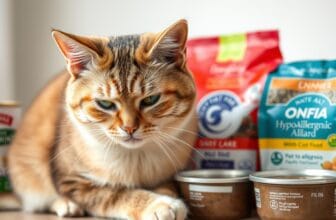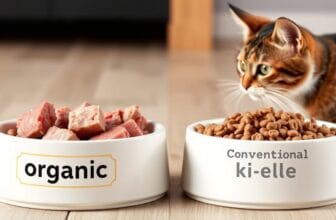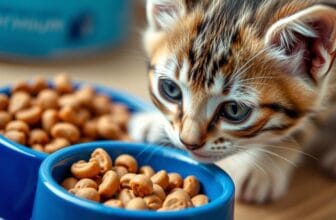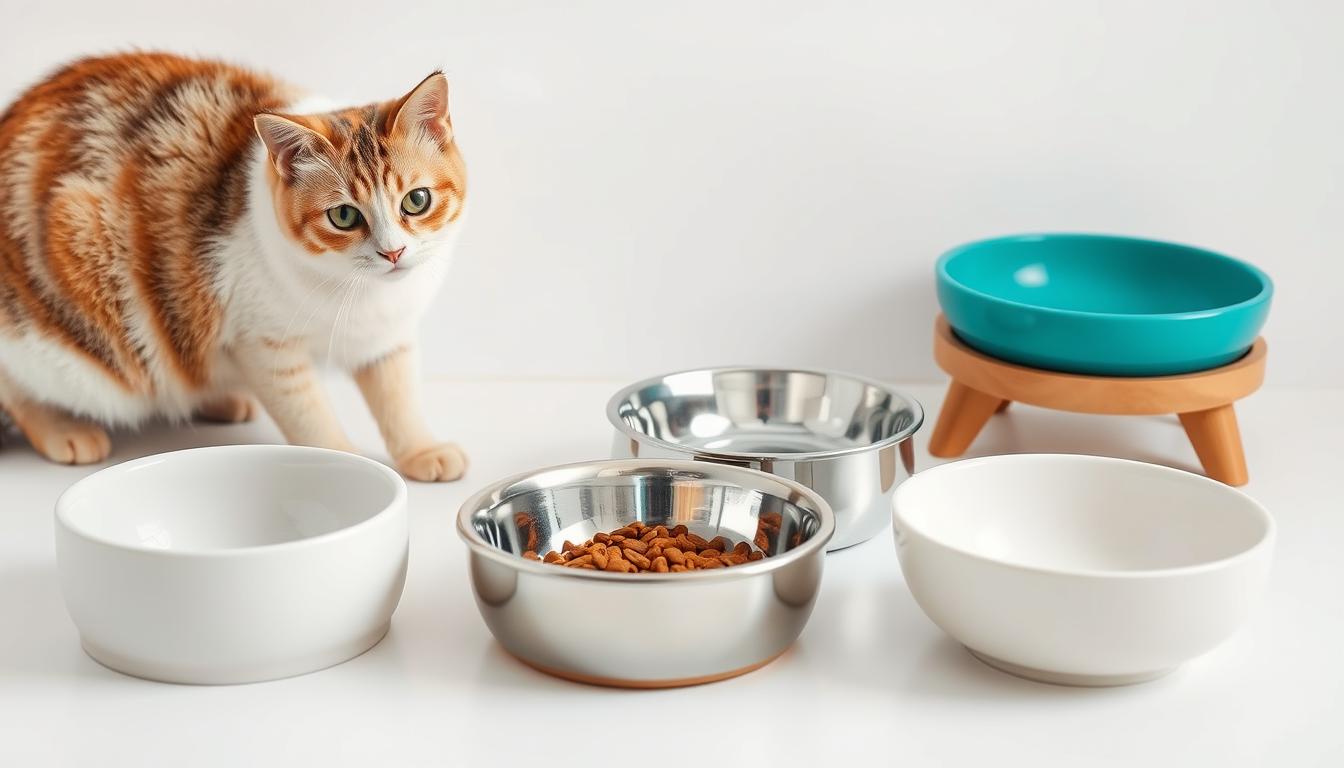
Types of Cat Food Bowls: Finding the Perfect Match
Cat food bowls come in various materials, each with distinct advantages and potential drawbacks. Understanding these differences will help you make an informed choice for your feline companion.
| Material | Pros | Cons | Best For |
| Ceramic | Heavy (won’t tip), dishwasher safe, stylish designs | Can chip or crack, may contain lead if low quality | Cats who tip bowls, aesthetic-minded owners |
| Stainless Steel | Extremely durable, dishwasher safe, bacteria resistant | Can slide on floors, limited designs | Cats with acne, hygienic concerns |
| Plastic | Lightweight, affordable, many designs | Scratches easily (harbors bacteria), may cause allergies | Temporary use, travel |
| Silicone | Non-slip, flexible, often collapsible for travel | May retain odors, less durable | Travel, messy eaters |
| Elevated/Tilted | Improves posture, reduces strain, aids digestion | More expensive, takes up more space | Older cats, cats with digestive issues |
Ceramic Cat Bowls
Ceramic bowls offer stability and aesthetic appeal. Their weight prevents tipping, making them ideal for enthusiastic eaters. High-quality ceramic bowls are glazed with non-toxic materials and come in countless designs to match your home decor.
Stainless Steel Cat Bowls
Stainless steel bowls are the veterinarian-recommended choice for hygiene and durability. They resist bacteria growth, don’t leach chemicals, and can withstand years of use and washing. Many come with non-slip bases to prevent sliding during eager mealtimes.
Plastic Cat Bowls
While affordable and lightweight, plastic bowls are generally not recommended for long-term use. They scratch easily, creating perfect hiding spots for bacteria. Some cats develop chin acne from plastic bowl exposure. If you choose plastic, opt for BPA-free options and replace them frequently.
Silicone Cat Bowls
Silicone bowls offer flexibility and non-slip properties. Many are collapsible, making them perfect for travel. Food-grade silicone resists bacteria better than plastic but may retain odors over time.
Elevated and Tilted Cat Bowls
Elevated or tilted bowls can improve your cat’s posture during meals and aid digestion. These are especially beneficial for older cats, those with arthritis, or flat-faced breeds who struggle with traditional bowls. The 15° tilt found in many designs helps prevent whisker fatigue while making food more accessible.
Key Features to Consider When Choosing Cat Food Bowls
Beyond material, several important features can make a significant difference in your cat’s dining experience. Here’s what to look for when selecting the perfect cat food bowl:
Size and Depth Matter
Cats prefer shallow, wide bowls that allow them to see their surroundings while eating and prevent whisker stress. A bowl 1-1.5 inches deep and 5-7 inches wide typically works well for most cats. For water, slightly deeper bowls prevent frequent refills.
Non-Slip Base
A secure, non-slip base prevents sliding and tipping during mealtime. Look for rubber or silicone bottoms that grip the floor while your cat eats. This feature is especially important for enthusiastic eaters who might push their bowls around.
Whisker-Friendly Design
Whisker fatigue occurs when a cat’s sensitive whiskers repeatedly touch the sides of a bowl. Wide, shallow dishes prevent this discomfort by giving whiskers plenty of clearance. Many bowls are specifically marketed as “whisker-friendly” or “whisker relief” designs.
Ease of Cleaning
Dishwasher-safe bowls make maintenance simple. Smooth surfaces without crevices prevent food buildup and bacteria growth. Consider how easy the bowl will be to clean when making your selection, as daily washing is recommended for food bowls.
Ready to find the perfect bowl for your cat?
Browse our selection of whisker-friendly, non-slip cat food bowls designed for your cat’s comfort and health.
Health and Safety Considerations for Cat Food Bowls
Your choice of cat food bowl can directly impact your pet’s health. Here are important health and safety factors to keep in mind:
Material Safety
Always choose food-grade, pet-safe materials. For plastic or silicone bowls, verify they’re BPA-free. With ceramic bowls, ensure they use food-safe glazes without lead or other toxins. Stainless steel should be food-grade (18/8 or 304-grade) to prevent rusting or leaching.
Hygiene and Cleaning
Bacteria can quickly multiply in dirty food bowls, potentially causing illness. Wash your cat’s food bowl daily with hot, soapy water or in the dishwasher if bowl-safe. Disinfect weekly by soaking in a solution of one part bleach to ten parts water, followed by thorough rinsing.
Bowl Placement Tips
Where you place your cat’s food bowl matters as much as the bowl itself. Keep food and water bowls separate, as many cats prefer not to drink near their food. Place bowls away from litter boxes and in quiet, low-traffic areas. For multi-cat households, provide separate feeding stations to prevent resource guarding.
Did You Know?
Cats can develop “whisker fatigue” when their sensitive whiskers repeatedly brush against the sides of deep, narrow bowls. This can cause stress and may lead to behavioral issues around mealtime.
Features to Avoid
- Deep, narrow bowls that cause whisker stress
- Low-quality plastic that can harbor bacteria
- Bowls with rough edges or uneven surfaces
- Decorative bowls with non-food-safe paints or glazes
- Extremely lightweight bowls that tip easily
Specialized Cat Food Bowl Solutions
Some cats have unique needs that require specialized feeding solutions. Here are options for specific situations:
Automatic Feeders
Automatic cat feeders dispense pre-measured portions at scheduled times. These are ideal for portion control, feeding while you’re away, or cats who wake you for early breakfast. Modern options include programmable timers, multiple meal compartments, and even smartphone control.
Slow-Feed Bowls
For cats who eat too quickly, slow-feed bowls feature ridges, mazes, or obstacles that make cats work for their food. This slows consumption, reduces vomiting, and provides mental stimulation. These specialized bowls come in various designs and difficulty levels.
Multi-Cat Household Solutions
Managing feeding in multi-cat homes can be challenging, especially with different diets or eating styles. Microchip feeders open only for specific cats, preventing food stealing. Feeding stations with dividers create personal space, while elevated platforms allow timid cats to eat without intimidation.
Bowls for Special Needs Cats
Cats with flat faces (brachycephalic breeds), mobility issues, or seniors may benefit from specially designed bowls. Tilted bowls at 15° angles help flat-faced breeds access food more easily. Extra-wide, shallow dishes accommodate cats with mobility limitations, while raised feeders reduce strain for arthritic or older cats.
DIY and Budget-Friendly Cat Food Bowl Options
You don’t need to spend a fortune to provide safe, effective feeding solutions for your cat. Here are some creative and affordable alternatives:
Repurposed Household Items
Many household items can be repurposed into cat-friendly dishes. Small, shallow plates from your kitchen work well for food. Ramekins make perfect portion-sized bowls for wet food. Just ensure any repurposed item is food-safe and has no chips or cracks.
Homemade Elevated Feeders
Create a simple elevated feeder using a sturdy box covered with contact paper or a small wooden platform. The ideal height should position the bowl 4-6 inches off the ground for most adult cats. Secure the bowls in place to prevent tipping.
Non-Slip Mat Solutions
Place regular bowls on a silicone baking mat, shelf liner, or dedicated pet mat to prevent sliding. This budget-friendly solution works with bowls you already own and helps contain messes during enthusiastic eating sessions.
Puzzle Feeder Alternatives
Create a simple slow feeder by placing a small ball or clean toy in a regular bowl, forcing your cat to eat around it. Alternatively, use a muffin tin or ice cube tray to separate small portions of food, encouraging slower eating and mental stimulation.
Share Your DIY Cat Bowl Ideas!
Have you created an innovative feeding solution for your cat? We’d love to see your creative ideas!
Top 5 Recommended Cat Food Bowls
Based on material quality, design features, and customer satisfaction, here are our top recommendations for cat food bowls:
1. Whisker Relief Ceramic Bowl
This wide, shallow ceramic bowl features a non-slip silicone base and dishwasher-safe construction. The 5.5″ diameter provides ample whisker clearance while the 1″ depth is perfect for both wet and dry food.
- Food-safe ceramic with lead-free glaze
- Dishwasher and microwave safe
- Holds 8oz of food
- Available in multiple colors
Price Range: $15-20
2. Stainless Steel Non-Slip Bowl Set
This durable stainless steel set includes two shallow bowls with removable rubber bases. The 18/8 food-grade steel resists bacteria and won’t absorb odors, while the rubber prevents sliding during enthusiastic eating.
- Dishwasher safe (remove rubber base first)
- 7oz capacity per bowl
- Rust and corrosion resistant
- Ideal for both food and water
Price Range: $8-12
3. Elevated Tilted Ceramic Bowl
Perfect for flat-faced breeds or senior cats, this elevated bowl features a 15° tilt for easier access to food. The ceramic construction is heavy enough to prevent tipping, while the 4″ height reduces strain on your cat’s neck.
- Dishwasher safe ceramic bowl
- Sturdy base prevents tipping
- 10oz capacity
- Helps reduce vomiting after meals
Price Range: $12-18
4. Slow Feeder Mat
For cats who eat too quickly, this innovative slow feeder features a maze-like design that makes mealtime more challenging. The food-grade silicone construction is flexible, easy to clean, and has a non-slip bottom.
- Dishwasher safe
- Works with both wet and dry food
- Provides mental stimulation
- Helps prevent digestive issues
Price Range: $8-15
5. Colorful Ceramic Bowl Set
This set of six colorful ceramic bowls provides variety while ensuring your cat always has a clean dish available. Each 5.75″ wide, shallow bowl is perfect for preventing whisker fatigue and comes in vibrant, attractive designs.
- Microwave and dishwasher safe
- 8.5oz capacity per bowl
- Lead-free ceramic construction
- Stylish designs complement home decor
Price Range: $18-25
Cleaning and Maintaining Cat Food Bowls
Proper cleaning and maintenance of your cat’s food bowls are essential for preventing bacterial growth and ensuring your pet’s health. Here are best practices for keeping feeding dishes clean and safe:
Daily Cleaning Routine
Wash food bowls daily with hot, soapy water. Use a dedicated sponge or brush for pet dishes to prevent cross-contamination with human dishes. Rinse thoroughly to remove all soap residue, which can cause digestive upset if ingested.
Deep Cleaning Methods
Once weekly, disinfect bowls to eliminate bacteria buildup. Soak in a solution of one part bleach to ten parts water for 10 minutes, then rinse thoroughly and allow to air dry. Alternatively, run dishwasher-safe bowls through a hot cycle.
Natural Cleaning Solutions
For those preferring natural alternatives, white vinegar makes an effective disinfectant. Create a solution of equal parts water and white vinegar, soak bowls for 15 minutes, then wash with mild dish soap and rinse thoroughly. Baking soda paste can help remove stubborn food residue.
When to Replace Bowls
Even with proper care, bowls eventually need replacement. Replace plastic bowls at the first sign of scratches or cloudiness. Ceramic bowls should be discarded if they develop cracks or chips. Stainless steel bowls are most durable but should be replaced if they show signs of rust or pitting.
Quick Tip
Keep at least one extra set of bowls on hand. This allows you to provide fresh dishes while soiled ones are being cleaned, ensuring your cat always has clean bowls available.
Choosing the Right Bowl for Your Cat’s Age and Needs
Ideal Bowl Types by Cat Age
- Kittens (0-12 months): Shallow, small ceramic or stainless steel bowls with non-slip bases. Their small size prevents overfeeding while developing proper eating habits.
- Adult Cats (1-7 years): Whisker-friendly wide bowls made of ceramic or stainless steel. Standard height works well for most healthy adults.
- Senior Cats (8+ years): Elevated bowls to reduce neck strain, with non-slip bases for stability. Slightly tilted designs can help cats with arthritis or mobility issues.
Signs Your Cat Dislikes Its Bowl
- Pawing at food or attempting to scoop it out of the bowl before eating
- Eating only from the center of the bowl while leaving the edges untouched
- Knocking the bowl over repeatedly before eating
- Appearing hesitant or stressed around mealtime
- Meowing for food but showing reluctance when approaching the bowl
Features to Avoid in Cat Food Bowls
- Deep, narrow designs that cause whisker stress during eating
- Lightweight materials that slide or tip easily during use
- Rough textures that can harbor bacteria or be difficult to clean
- Decorative elements that might contain toxic materials
- Extremely small bowls that require frequent refilling
Finding the Perfect Cat Food Bowl
Choosing the right cat food bowl is an important aspect of responsible pet ownership. The perfect bowl balances your cat’s comfort, health needs, and your practical considerations like cleaning and durability. Whether you opt for a whisker-friendly ceramic dish, a hygienic stainless steel option, or a specialized solution for unique needs, your cat will benefit from your thoughtful selection.
Remember that individual preferences vary among cats. Don’t be discouraged if your first choice doesn’t seem to please your feline friend. Observe their behavior during mealtimes and be willing to try different options until you find the perfect match. With the right feeding solution, mealtime can become a stress-free, enjoyable experience for both you and your cat.
Share Your Cat’s Feeding Setup!
We’d love to hear about your experiences with different cat food bowls. What works best for your feline friend?




















